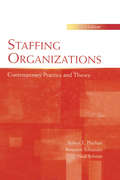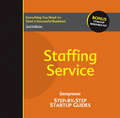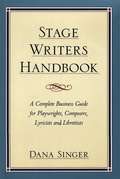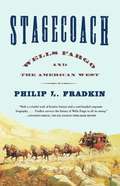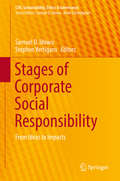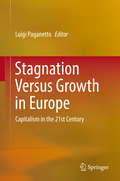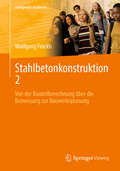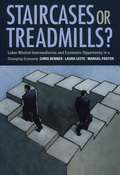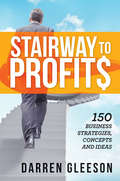- Table View
- List View
Staffing Organizations: Contemporary Practice and Theory (Applied Psychology Series)
by Benjamin Schneider Robert E. Ployhart Neal SchmittStaffing Organizations: Contemporary Practice and Theory, the new third edition of a classic in the field, shows how organizations of all sizes can use effective staffing procedures as a source of sustained competitive advantage. Practically, the book shows how to choose, develop, and administer effective staffing procedures, including condu
Staffing Service
by Entrepreneur Magazine Krista TurnerThe new world economy is tough on job security. Hordes of skilled, experienced, motivated workers are flooding the market, looking for work. And lots of merged and downsized companies now outsource the work that used to be done by permanent employees. The bright side? It's prime time for the staffing profession.Detailing the hottest specialties in the staffing service industry-facilities staffing, industrial staffing, office/clerical staffing, temp staffing and temp-to-perm staffing-the experts at Entrepreneur provide everything eager entrepreneurs need to know to start their own staffing service.Covers:-Industry trends and opportunities-Identifying a specialty-How to establish the business-from securing licenses and financing to buying equipment and recruiting employees-Building a client base-Promoting and marketing the business-Managing day-to-day operations-Staying on top of financesEntrepreneurs also gain priceless insight from practicing entrepreneurs who reveal little-known tricks of the trade and common hazards to avoid. Aspiring business owners are given sample documents, worksheets, and other example materials to reference as they move their business forward. Specialties covered include: Facilities staffing-placing employees in long-term or indefinite-length assignments Industrial staffing-specializing in manual laborers, food handlers, cleaners, assemblers, drivers, tradespeople, machine operators, etc. Office/clerical staffing-focusing on secretaries, receptionists, administrative assistants, word processing and data-entry operators, etc. Temporary staffing-supplying client companies with workers on a short-term basis Temp-to-perm staffing-offering clients a convenient way to try out temporary workers for permanent positionsAll Entrepreneur Step-By-Step Startup Guides Include: Essential industry-specific startup steps with worksheets, calculators, checklists and more Bestselling title,Start Your Own Business by Entrepreneur Media Inc., a guide to starting any business and surviving the first three years Downloadable, customizable business letters, sales letters, and other sample documents Entrepreneur's Small Business Legal Toolkit
Staffing the ATM System: The Selection of Air Traffic Controllers
by Hinnerk Eißfeldt Mike C. HeilIssues of personnel development in air traffic control (ATC) have become a major topic in aviation recruitment and training. Proper selection and training methods are needed in order to reach a high level of efficiency and reliability in ATC. Pilots were considered the most prominent group in aviation for a long time, but with the development of flight guidance technologies came a second operational occupation in aviation: the air traffic controller (ATCO). This volume provides a state-of-the-art overview of controller selection from an impressive collection of international specialists in research and practice. It will prove a valuable and key insight into the demands of air traffic controller selection through its comprehensive and enlightening examination of the current practice in the USA and Europe for the job-analysis requirements of future air traffic management (ATM) systems.
Stage II: Standard Cost and Flexible Budgeting Systems
by Robert S. Kaplan Robin CooperAlthough today some companies have characteristics of the broken systems in Stage I, most are operating with Stage II systems. Even with excellent design, standard Stage II cost systems can have serious limitations for costing processes, products, customers, and providing timely feedback to front-line employees. Focusing on these Stage II systems, this chapter provides a baseline for the improvements documented in the remainder of the book for making systems more relevant and useful for managerial purposes. It also includes an appendix on the GPK cost system.
Stage III Systems for Learning and Improvement: Kaizen Costing and Pseudo-Profit Centers
by Robert S. Kaplan Robin CooperHow have Japanese and U.S. companies used financial measurement systems, like kaizen costing and pseudo-profit centers, which are meant to provide direct financial feedback to employees, as part of their continuous improvement efforts? This chapter illustrates several innovative approaches to developing the general design principles for operational control systems that promote learning and improvement opportunities by front-line employees, so they can build more efficient processes.
Stage III Systems for Learning and Improvement: Upgrading and Supplementing Standard Cost Systems
by Robert S. Kaplan Robin CooperEmployees need an appropriate mixture of financial and nonfinancial measurements--especially cost, quality, yields, and cycle time--or processes under their control. This chapter describes how standard costing systems can be made more timely and responsive in providing feedback on financial expenses, and explains how supplementing financial systems with nonfinancial measures can empower employees.
Stage IV: Integrating ABC with Enterprise-Wide Systems
by Robert S. Kaplan Robin CooperToday, many companies are investing not only in stand-alone Stage III ABC (activity-based costing) systems, but in enterprise-wide systems (EWS) as well. EWS can provide a company with an integrated set of operating, financial, and management systems. This chapter describes how to integrate ABC and enterprise-wide systems to support fact-based decision making across a wide range of organizational activities, and provide information about future operations. This is the vision for Stage IV.
Stage IV: Using ABC for Budgeting and Transfer Pricing
by Robert S. Kaplan Robin CooperWhen managers have access to integrated Stage IV systems, they can use their ABC (activity-based costing) model to provide information for important, ongoing managerial processes, including budgeting, what-if analysis, and transfer pricing. This chapter builds on the vision for the future outlined in chapter 14 to describe how the ABC system can be used as the foundation for budgeting--on a rational, analytic basis--the organization's future expenses and resource supply.
Stage Writers Handbook
by Dana SingerDana Singer, Associate Director of America's foremost playwrights' association, the Dramatists Guild, gathers all the information and ideas stage writers need to conduct their careers in a businesslike manner, with all the protections the law provides. Includes chapters devoted to copyright, self-promotion, representation, production contracts, publishing and licensing agreements, underlying rights and collaboration.
Stagecoach
by Philip L. FradkinSweeping in scope, as revealing of an era as it is of a company, Stagecoach is the epic story of Wells Fargo and the American West, by award-winning writer Philip L. Fradkin. The trail of Wells Fargo runs through nearly every imaginable landscape and icon of frontier folklore: the California Gold Rush, the Pony Express, the transcontinental railroad, the Civil and Indian Wars. From the Great Plains to the Rockies to the Pacific Ocean, the company's operations embraced almost all social, cultural, and economic activities west of the Mississippi, following one of the greatest migrations in American history. Fortune seekers arriving in California after the discovery of gold in 1849 couldn't bring the necessities of home with them. So Wells Fargo express offices began providing basic services such as the exchange of gold dust for coin, short-term deposits and loans, and reliable delivery and receipt of letters, money, and goods to and from distant places. As its reputation for speed and dependability grew, the sight of a red-and-yellow Wells Fargo stagecoach racing across the prairie came to symbolize not only safe passage but faith in a nation's progress. In fact, for a time Wells Fargo was the most powerful and widespread institution in the American West, even surpassing the presence of the federal government. Stagecoach is a fascinating and rare combination of Western and business history. Along with its colorful association with the frontier -- Wyatt Earp, Black Bart, Buffalo Bill -- readers will discover that swiftness, security, and connectivity have been constants in Wells Fargo's history, and that these themes remain just as important today, 150 years later.
Staged to Sell (or Keep)
by Jean NayarClearly organized room-by-room, filled with photos of inspiring rooms, and brimming with expert tips, this book shows you how to recognize the strengths and weaknesses of you home and to bring out its best to improve its value.
Stages of Capital: Law, Culture, and Market Governance in Late Colonial India
by Ritu BirlaIn Stages of Capital, Ritu Birla brings research on nonwestern capitalisms into conversation with postcolonial studies to illuminate the historical roots of India's market society. Between 1870 and 1930, the British regime in India implemented a barrage of commercial and contract laws directed at the "free" circulation of capital, including measures regulating companies, income tax, charitable gifting, and pension funds, and procedures distinguishing gambling from speculation and futures trading. Birla argues that this understudied legal infrastructure institutionalized a new object of sovereign management, the market, and along with it, a colonial concept of the public. In jurisprudence, case law, and statutes, colonial market governance enforced an abstract vision of modern society as a public of exchanging, contracting actors free from the anachronistic constraints of indigenous culture. Birla reveals how the categories of public and private infiltrated colonial commercial law, establishing distinct worlds for economic and cultural practice. This bifurcation was especially apparent in legal dilemmas concerning indigenous or "vernacular" capitalists, crucial engines of credit and production that operated through networks of extended kinship. Focusing on the story of the Marwaris, a powerful business group renowned as a key sector of India's capitalist class, Birla demonstrates how colonial law governed vernacular capitalists as rarefied cultural actors, so rendering them illegitimate as economic agents. Birla's innovative attention to the negotiations between vernacular and colonial systems of valuation illustrates how kinship-based commercial groups asserted their legitimacy by challenging and inhabiting the public/private mapping. Highlighting the cultural politics of market governance, Stages of Capital is an unprecedented history of colonial commercial law, its legal fictions, and the formation of the modern economic subject in India.
Stages of Corporate Social Responsibility
by Samuel O. Idowu Stephen VertigansThis book presents a multidisciplinary and multifaceted view of the state of corporate social responsibility (CSR) development in organizations in different industries around the world. It is based on the assumption that companies today must shift their focus to their long-term prosperity and the complex and interrelated environmental, social, economic and political ecosystems within which they function. The book tracks ideas through to impacts, offering unique perspectives on stimulating topics such as awareness among female entrepreneurs in Nigeria, views of upper-management in Polish firms, Japanese CSR strategies and the social relevance of corporate initiatives, pragmatic approaches of CSR design principles in Scandinavia and many more. The book collects not only examples from different countries and global regions, but also cases from a diverse range of globally relevant industries. It discusses the different stages of CSR development at a professional, conceptual and strategic level, and integrates them into a comprehensive framework to define the adequate course of action for each stage.
Stagflation: the 1970s and the Crisis of the Postwar System
by Jonathan Schlefer Jeremy FriedmanCase
Staging 21st Century Tragedies: Theatre, Politics, and Global Crisis
by Avra SidiropoulouStaging 21st Century Tragedies: Theatre, Politics, and Global Crisis is an international collection of essays by leading academics, artists, writers, and curators examining ways in which the global tragedies of our century are being negotiated in current theatre practice. In exploring the tragic in the fields of history and theory of theatre, the book approaches crisis through an understanding of the existential and political aspect of the tragic condition. Using an interdisciplinary perspective, it showcases theatre texts and productions that enter the public sphere, manifesting notably participatory, immersive, and documentary modes of expression to form a theatre of modern tragedy. The coexistence of scholarly essays with manifesto-like provocations, interviews, original plays, and diaries by theatre artists provides a rich and multifocal lens that allows readers to approach twenty-first-century theatre through historical and critical study, text and performance analysis, and creative processes. Of special value is the global scope of the collection, embracing forms of crisis theatre in many geographically diverse regions of both the East and the West. Staging 21st Century Tragedies: Theatre, Politics, and Global Crisis will be of use and interest to academics and students of political theatre, applied theatre, theatre history, and theatre theory.
Staging Deaf and Hearing Theatre Productions: A Practical Guide
by Andy Head Jill Marie BradburyThis book explores an unacknowledged gap in theatre study and praxis, and establishes an inceptive model for transforming a playscript into a theatrical production involving deaf and hearing artists. The book stipulates that theatrical productions of this nature should strive to go beyond accessibility towards inclusivity by considering deaf perspectives at every stage of the process: When deaf actors are cast in roles assumed to be hearing, how does this change the world of the play? How does the inclusion of a visual language affect staging decisions? How can truly equal access to two different language modalities be achieved for diverse production teams and audiences? Because deaf artists should be involved in the leadership and creative decision making throughout the process, this book is co-written by a deaf and hearing team. The main topics of the book include pre-production preparation, the rehearsal process, and performance. As deaf theatre artists move increasingly into the foreground, it’s time for the hearing theatre world to learn how to undertake productions that successfully bridge the deaf and hearing worlds. By including the perspective of directors, actors, designers, and audience members, this guide lays out an ideal process towards achieving that goal.
Staging Organization
by Steven S. TaylorThis original and thought-provoking book takes a new approach to engaging with organizational theory and making sense of organizations. Consisting of seven plays written by the author, each is followed by a stimulating commentary by a noted scholar, exploring the wider contexts and values of applying theatre to organisational environments and management education. As the first work of this type in organisational theatre, this book will be of interest to scholars in the field of organisational learning, leadership training, art management, arts-based learning and creativity innovation. Alongside the scholarly discussion, the author provides the reader with the opportunity to experience the plays and apply them to education, research and the workplace. Including seven plays and commentaries Soft Targets- Capitalist Pigs- Blasphemy & Doubt- Cow Going Abstract- The Invisible Foot The Age of Loneliness- Through the Reading Glasses
Staging Two-sided Platforms
by Thomas R. Eisenmann Andrei HagiuFirms that aspire to develop two-sided platforms face a formidable challenge. Prospective users on each side will not invest in the platform until they are confident there will be enough users on the other side. Traditional strategies for dealing with this dilemma--subsidizing users or securing their exclusive affiliation--are costly and risky. Describes less costly staged strategies for building two-sided platforms. With the "vendor to two-sided platform" strategy, a firm starts as a vendor selling products or services to customers on just one side of a potential--but not yet existing--two-sided network. Once the first side is firmly established, it proves easier to attract users to the network's other side during stage two. With the "merchant to two-sided platform" strategy, a firm starts as a merchant buying goods from many different suppliers and reselling them, in the process absorbing all the risk of platform failure. In stage two, the firm shifts risk and control back to some or all of its suppliers, giving them more responsibility for managing inventory, pricing, and merchandising their wares. Presents examples and offers guidelines for when to use each strategy.
Staging a Comeback: Broadway, Hollywood, and the Disney Renaissance
by Peter C. KunzeIn the early 1980s, Walt Disney Productions was struggling, largely bolstered by the success of its theme parks. Within fifteen years, however, it had become one of the most powerful entertainment conglomerates in the world. Staging a Comeback: Broadway, Hollywood, and the Disney Renaissance argues that far from an executive feat, this impressive turnaround was accomplished in no small part by the storytellers recruited during this period. Drawing from archival research, interviews, and textual analysis, Peter C. Kunze examines how the hiring of theatrically trained talent into managerial and production positions reorganized the lagging animation division and revitalized its output. By Aladdin, it was clear that animation—not live action—was the center of a veritable “renaissance” at Disney, and the animated musicals driving this revival laid the groundwork for the company’s growth into Broadway theatrical production. The Disney Renaissance not only reinvigorated the Walt Disney Company but both reflects and influenced changes in Broadway and Hollywood more broadly.
Staging to Sell
by Barb SchwarzHome staging strategies needed to succeed in a down market Whether a buyer, seller, or real estate agent, the home selling and purchasing process is fraught with potholes that can usually be overcome. But in this weakened housing market, everyone involved in the selling process must increase their efforts. In order to sell homes at top dollar, houses must be "prepared for sales. " That's where Staging comes in. The real estate mantra is no longer location, location, location. It is now Staging, Staging, Staging! It's all about presentation. In Staging to Sell, Barb Schwarz, The Creator of Home Staging®, offers her winning tactics, secrets, and strategies for selling a home at top dollar during these challenging times. In addition to offering specific tips on how to Stage a home, Schwarz, a sought-after speaker and Real Estate broker who has Staged and sold over 5,000 homes, provides readers, sellers, Realtors® and Stagers, with useful advice on correctly pricing properties, marketing properties so that they sell, addressing objections early on, having the seller handle the Staging before the house is viewed, and much more. Written with today's turbulent real estate market in mind, Staging to Sell contains the information readers need to get their homes Sold in the market quickly for top dollar.
Stagnation Versus Growth in Europe
by Luigi PaganettoThis book explores the debate on the policies required to overcome the crises of 2008 and 2011, in which the focus on short-term measures has overshadowed the need to analyze the low growth rate in the European Union, and especially the Eurozone, as the basis for interventions that will counteract the tendency toward stagnation. Factors that lie at the root of the low growth are examined in depth, covering, for example, the impact of the demographic trend toward an aging population in Europe, consequences of inequality for growth, challenges posed by technological change, competition from emerging countries, and difficulties in improving European governance. In addition, potential actions to foster innovation and avoid long-term stagnation, such as new measures to open up markets, stimulate competition in services, and promote green growth, are discussed. The book comprises a selection of contributions presented at the XXVII Villa Mondragone International Economic Seminar, which brought together renowned economists and representatives of a broad range of countries and leading international institutions. It will appeal to all who are interested in the latest thinking on stagnation/growth, inequality, governance, competitiveness, and innovation in Europe.
Stahlbetonkonstruktion 2: Von der Bauteilberechnung über die Bemessung zur Bauwerksplanung (erfolgreich studieren)
by Wolfgang FinckhAufbauend auf dem ersten Teil „Stahlbetonkonstruktion“ werden in diesem Teil erweiterte Grundlagen der Stahlbetonberechnung erläutert. Neben den Torsionsnachweisen, dem genaueren Verfahren zur Durchbiegeberechnung und den Schnittgrößenumlagerungen werden vor allem besonders häufig vorkommende Stahlbetonbauteile behandelt. Zu diesen Bauteilen zählen Aussteifungssysteme, Bodenplatten, Fundamente, liniengelagerte Platten sowie Elementdecken. Hierbei werden bei diesen Bauteilen, welche nahezu in jedem Bauwerk vorkommen, sowohl die Ermittlung der Schnittgrößen wie auch die Bemessung und konstruktive Durchbildung erklärt. Zusätzlich wird in diesem Lehrbuch auch die Bemessung des Werkstoffes Stahlfaserbeton, welcher insbesondere bei Bodenplatten im Industriebau verwendet wird, erläutert. Die im Lehrbuch vorgestellten theoretischen Grundlagen werden anhand zahlreicher Abbildungen verdeutlicht. In jedem Kapitel sind zum besseren Verständnis umfangreiche Bemessungsbeispiele mit Praxisbezug enthalten. Nach der erfolgreichen Lektüre des ersten Bandes der Reihe „Stahlbetonkonstruktion“ wird in diesem zweiten Band das Wissen gefestigt und stark erweitert. Dies ermöglicht dem Lesenden einen sicheren Umgang mit dem Werkstoff Stahlbeton.
Staircases or Treadmills?: Labor Market Intermediaries and Economic Opportunity in a Changing Economy
by Chris Benner Manuel Pastor Laura LeeteGlobalization, technological change, and deregulation have made the American marketplace increasingly competitive in recent decades, but for many workers this “new economy” has entailed heightened job insecurity, lower wages, and scarcer benefits. As the job market has grown more volatile, a variety of labor market intermediaries—organizations that help job seekers find employment—have sprung up, from private temporary agencies to government “One-Stop Career Centers.” In Staircases or Treadmills? Chris Benner, Laura Leete, and Manuel Pastor investigate what approaches are most effective in helping workers to secure jobs with decent wages and benefits, and they provide specific policy recommendations for how job-matching organizations can better serve disadvantaged workers. Staircases or Treadmills? is the first comprehensive study documenting the prevalence of all types of labor market intermediaries and investigating how these intermediaries affect workers’ employment opportunities. Benner, Leete, and Pastor draw on years of research in two distinct regional labor markets—“old economy” Milwaukee and “new economy” Silicon Valley—including a first-of-its-kind random survey of the prevalence and impacts of intermediaries, and a wide range of interviews with intermediary agencies’ staff and clients. One of the main obstacles that disadvantaged workers face is that social networks of families and friends are less effective in connecting job-seekers to stable, quality employment. Intermediaries often serve as a substitute method for finding a job. Which substitute is chosen, however, matters: The authors find that the most effective organizations—including many unions, community colleges, and local non-profits—actively foster contacts between workers and employers, tend to make long-term investments in training for career development, and seek to transform as well as satisfy market demands. But without effective social networks to help workers locate the best intermediaries, most rely on private temporary agencies and other organizations that offer fewer services and, statistical analysis shows, often channel their participants into jobs with low wages and few benefits. Staircases or Treadmills? suggests that, to become more effective, intermediary organizations of all types need to focus more on training workers, teaching networking skills, and fostering contact between workers and employers in the same industries. A generation ago, rising living standards were broadly distributed and coupled with relatively secure employment. Today, many Americans fear that heightened job insecurity is overshadowing the benefits of dynamic economic growth. Staircases or Treadmills? is a stimulating guide to how private and public job-matching institutions can empower disadvantaged workers to share in economic progress.
Stairway to Profits: 150 Business Strategies, Concepts and Ideas
by Darren GleesonThis book details 150 strategies, concepts and ideas, that if implemented will give you a more profitable, more valuable, and more enjoyable business. These strategies apply irrespective of the type of business you own, the size of the business, or even your level of business experience.These 150 strategies and ideas have the potential to transform your business. You have an amazing journey ahead of you with the potential for this to turn into a genuinely satisfying and rewarding business adventure. Enjoy the diversity and new found scope for visualising, exploring and transforming your business in multiple ways.
Stakeholder Analysis Tool
by Lynda M. ApplegateThis exercise enables users to: identify stakeholders and analyze their interests and expectations; categorize interests and expectations based on importance; and develop an action plan.
